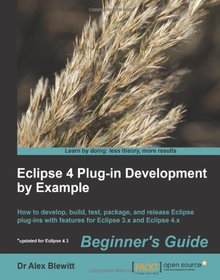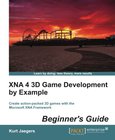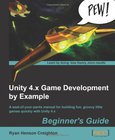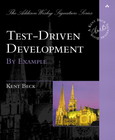Eclipse 4 Plug-in Development by Example
Beginner's Guide

Book Details:
| Publisher: | Packt Publishing |
| Series: | Packt , By Example |
| Author: | Dr. Alex Blewitt |
| Edition: | 1 |
| ISBN-10: | 1782160329 |
| ISBN-13: | 9781782160328 |
| Pages: | 348 |
| Published: | Jun 20 2013 |
| Posted: | Nov 19 2014 |
| Language: | English |
| Book format: | |
| Book size: | 6.99 MB |
Book Description:
How to develop, build, test, package, and release Eclipse plug-ins with features for Eclipse 3.x and Eclipse 4.x Overview Create plug-ins to extend the Eclipse runtime covering Eclipse 3.x and the changes required for Eclipse 4.x Plug-ins from design to distribution wide coverage of the entire process No prior OSGi or Eclipse plug-in development experience necessary In Detail As a highly extensible platform, Eclipse is used by everyone from independent software developers to NASA. Key to this is Eclipses plug-in ecosystem, which allows applications to be developed in a modular architecture and extended through its use of plug-ins and features. "Eclipse Plugin Development by Example: Beginner's Guide" takes the reader through the full journey of plug-in development, starting with an introduction to Eclipse plug-ins, continued through packaging and culminating in automated testing and deployment. The example code provides simple snippets which can be developed and extended to get you going quickly. This book covers basics of plug-in development, creating user interfaces with both SWT and JFace, and interacting with the user and execution of long-running tasks in the background. Example-based tasks such as creating and working with preferences and advanced tasks such as well as working with Eclipses files and resources. A specific chapter on the differences between Eclipse 3.x and Eclipse 4.x presents a detailed view of the changes needed by applications and plug-ins upgrading to the new model. Finally, the book concludes on how to package plug-ins into update sites, and build and test them automatically. What you will learn from this book How to create plug-ins for Eclipse 3.x and 4.x and automatically test plug-ins with JUnit How to display tree and table information in views What are the specific differences between the Eclipse 3.x model and the Eclipse 4.x model How and when to build user interfaces from SWT and JFace How to run tasks in the background and update the user interface asynchronously How to build plug-ins, features and update sites with Maven Tycho and automate user interface tests with SWTBot How to store and obtain preferences, and how to integrate with the Preferences panel How to work with the Eclipse resources model for creating and updating files and reporting errors to the user Approach A Beginner's Guide following the "by Example" approach. There will be 5-8 major examples that will be used in the book to develop advanced plugins with the Eclipse IDE. Who this book is written for This book is for Java developers who are familiar with Eclipse as a Java IDE and are interested in learning how to develop plug-ins for Eclipse. No prior knowledge of Eclipse plug-in development or OSGi is necessary, although you are expected to know how to create, run, and debug Java programs in Eclipse.
Download Link:
Related Books:
XNA 4 3D Game Development by Example
Beginner's Guide
Create action-packed 3D games with the Microsoft XNA Framework Overview Learn the structure of a 3D world and how to implement a variety of 3D techniques including terrain generation and 3D model rendering. Build three different types of 3D games step-by-step, including a first-person maze game, a battlefield tank game, and a 3D sidescrolling action game on the surface of Mars. Learn to utilize High Level Shader Language (HLSL) to add lighting and multi-texturing effects to your 3D scenes. In Detail Move beyond the world of flat 2D-based game development and discover how to create your own exciting 3D games with Microsoft XNA 4.0. Create a 3D maze, fire shells at enemy tanks, and drive a rover on the surface of Mars while being attacked by alien sa...
Unity 4.x Game Development by Example
Beginner's Guide
A seat-of-your-pants manual for building fun, groovy little games quickly with Unity 4.x Overview Learn the basics of the Unity 3D game engine by building five small, functional game projects Explore simplification and iteration techniques that will make you more successful as a game developer Take Unity for a spin with a refreshingly humorous approach to technical manuals In Detail Unity is one of the biggest game engines in the world, providing the user with a range of important tools that they need to bring their ideas into reality. Beginner game developers are optimistic, passionate, and ambitious, but that ambition can be dangerous! Too often, budding indie developers and hobbyists bite off more than they can chew. Games like Angry Birds, Cut ...
Test Driven Development
By Example
Quite simply, test-driven development is meant to eliminate fear in application development. While some fear is healthy (often viewed as a conscience that tells programmers to "be careful!"), the author believes that byproducts of fear include tentative, grumpy, and uncommunicative programmers who are unable to absorb constructive criticism. When programming teams buy into TDD, they immediately see positive results. They eliminate the fear involved in their jobs, and are better equipped to tackle the difficult challenges that face them. TDD eliminates tentative traits, it teaches programmers to communicate, and it encourages team members to seek out criticism However, even the author admits that grumpiness must be worked out individually! I...
2007 - 2021 © eBooks-IT.org



